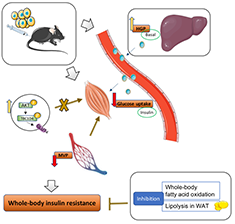PhD defence: Insulin action related to muscle hypertrophy and cancer
Xiuqing Han
PhD thesis

Insulin resistance (IR) is often associated with conditions of reduced muscle mass, while a high muscle mass is often associated with high insulin sensitivity. However, the molecular explanations for a possible relationship between muscle mass and insulin sensitivity are lacking.
In the current thesis, insulin sensitivity and molecular regulation were determined in two studies, study 1) Follistatin (Fst) -induced muscle mass increase, and study 2) tissue wasting condition of cancer.
In Study 1, muscle Fst expression was increased in mouse skeletal muscle by recombinant adeno associated virus (rAAV) transfection to induce muscle hypertrophy. Fst288 overexpression increased muscle mass accompanied by augmented insulin-stimulated muscle glucose uptake and AKT/TBC1D4 signaling and restored impaired insulin action in obese insulin resistant mice in 2 weeks.
In Study 2, Lewis lung carcinoma (LLC) cancer impaired insulin’s stimulatory effect on glucose uptake in both muscle and adipose tissue and impaired microvascular perfusion in muscle. It also increases basal hepatic glucose production. Additionally, blockage of lipid flux partially alleviates cancer-induced IR which could be a novel pharmacological target for cancer treatment in the future.
However, cancer cell-secreted factors augmented both basal and insulin-stimulated myoblast’s GLUT4 translocation. Taken together, these results support an association between insulin sensitivity and muscle mass regulation and describe novel molecular players.
2020, 123 pages.
Time
10 February 2020, 14:00
Place
Auditorium A1-01.01, Festauditoriet, Bülowsvej 17, Frederiksberg
Opponents
Associate professor Faidon Magkos (chair), Department of Nutrition, Exercise and Sports, University of Copenhagen, Denmark.
Professor Bert Blaauw, University of Padova, Italy.
Professor Jørgen Jensen, Norwegian School of Sport Sciences, Norway.
Supervisor
Professor Erik Richter, Department of Nutrition, Exercise and Sports, University of Copenhagen, Denmark.
Co supervisor
Assistant professor Lykke Sylow, Department of Nutrition, Exercise and Sports, University of Copenhagen, Denmark.
The thesis is available for inspection at Nørre Allé 51, DK-2200 Copenhagen N.
